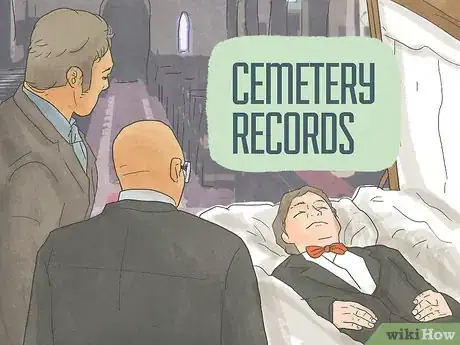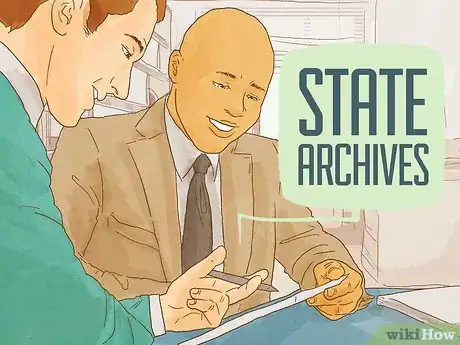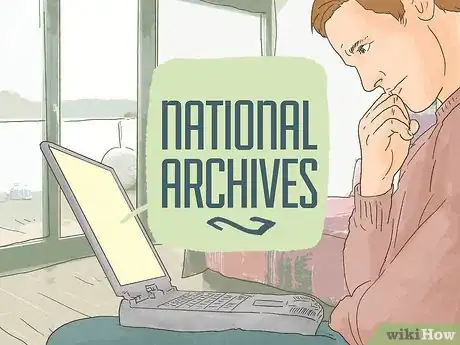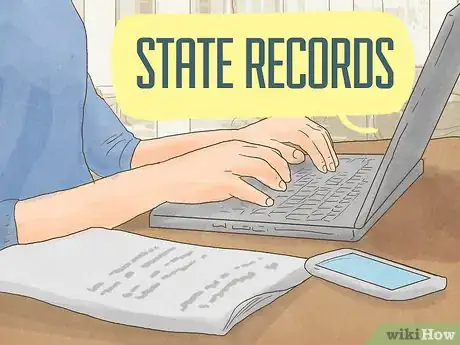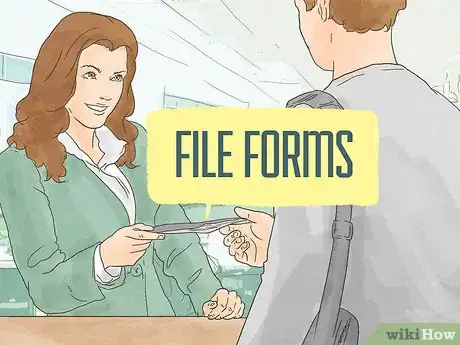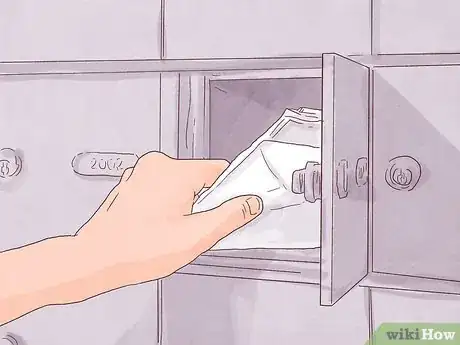This article was written by Jennifer Mueller, JD. Jennifer Mueller is an in-house legal expert at wikiHow. Jennifer reviews, fact-checks, and evaluates wikiHow's legal content to ensure thoroughness and accuracy. She received her JD from Indiana University Maurer School of Law in 2006.
There are 14 references cited in this article, which can be found at the bottom of the page.
This article has been viewed 35,074 times.
In some circumstances, such as if you are researching your family's genealogy, you might need to find an official death notice. This search can be all the more difficult if you don't know where or exactly when the person died. However, there are numerous online databases and other public resources you can access – many are free, although some may charge a small fee or require a subscription – to find a death notice.
Steps
Searching Online
-
1Check the online Social Security Death Index. The SSDI includes the record of anyone with a U.S. Social Security number whose death was reported to the Social Security Administration.[1]
- Websites such as genealogybank.com and ancestry.com allow you to access portions of the SSDI free of charge.
- You can search the SSDI by the person's first and last name, date of birth, date of death, last known residence, Social Security number, or any combination thereof.[2]
- If you have limited information about the person for whom you need a death notice, you can use the information in the SSDI to fill in the blanks. For example, if you are looking for the death notice for your great-great grandmother, and you know her first and last name but not exactly when or where she died, you may be able to find a listing in the SSDI that would provide you with that information. Once you know when and where she died, you have a better idea of where else to look to find her death notice.
-
2Search for city or state death records databases. Many larger cities and some states have online databases available for use by the general public.
- State death indexes typically go back further in time than the SSDI, so if you're looking for the death notice of someone who died in the 1700s, for example, you'd be more likely to find the information at the state level.
- Although some of these indexes are available online for free, those databases typically only cover deaths through the early 1900s. If you're looking for an older death, you may have to pay a one-time fee or join a subscription site to gain access to the records.[3]
Advertisement -
3Look for newspaper obituaries. Depending on your purpose, a newspaper obituary may be all you need to get details of a person's death.
- Keep in mind that for most people, the write-up in the paper is the official death notice. The death notice generally gives a brief story of the person's life and lists their surviving family members and the arrangements made. Newspaper staff writers typically create obituaries only for famous or significant people.[4]
- In small towns, the newspaper may include more staff-written obituaries. You also might find obituaries or reprints of the death notice in church or community newsletters.[5]
- If someone lived most of their life in one place, but died in another, their hometown often will reprint the death notice. So if you're not sure exactly where the person died, but you know where they were born and grew up, try checking the newspapers there.
- Some newspapers publish their archives online, while others make their obituaries available on websites such as legacy.com.[6]
- Several websites such as obitsforlife.com offer a searchable database of funeral home death notices, which for most people would be the notice published in the local newspaper.
- Some of these websites allow you to search for free, but require you to pay a fee or sign up for a subscription service before they grant you access to the records.[7]
Using Public Archives
-
1Go to the public library. Local libraries typically archive materials such as local newspapers that you may not be able to find anywhere else.
- The main branch of your local library typically has the entire archives of the local newspaper from the date of the first issue, usually on microfilm or microfiche.
- For example, the New York Public Library has microform copies of The New York Times beginning with issues from 1857.
- Unfortunately, many of these microform collections are not searchable the way an online database would be, but if you know the approximate date of the person's death, you can scan through the newspapers until you find the published notice.
- Many local libraries also provide free access to databases such as NewsBank, which let you search newspaper obituaries and death notices nationwide. These databases typically are only available with a paid subscription, but library subscriptions enable patrons to enjoy free access.[8]
-
2Look for cemetery or burial records. If you know where the person was buried, you may be able to find a listing in the cemetery's records that provides more information about the person's death.
- Cemetery records typically catalogue everyone buried there, since gravestones can become weathered and illegible over time. Burial records can be particularly helpful if you know where the person is buried but can't find their grave.
- Although typically you have to visit the cemetery itself to view these records, some districts now have their records available online. For example, you can use the Orange County Cemetery District's searchable database to find graves in Anaheim Cemetery, El Toro Memorial Park, and Santa Ana Cemetery.[9]
-
3Visit your state archives facility. If the person died in the United States, you probably can find death notices and additional information by researching at the state archives.
- Keep in mind these facilities typically are located in the state's capital. However, if you're unable to travel to that city to review the documents in person, you may be able to request them through the library of a local university or historical society.[10]
- State archives tend to have older records than Social Security or other national records, and the records themselves may go into greater detail.
-
4Research at a National Archives records center. The National Archives has a network of research facilities across the country that have federal records and other resources available.
- For example, ancestry.com and other such services are available free of charge on computers at Archives facilities.[11] You may be able to find records on those services that you wouldn't otherwise be able to access without paying for a subscription.
- You can find the location you need on the National Archives website at http://www.archives.gov/locations/. The directory lists the address of each facility along with the particular services offered there.
- If you're looking for the death notice of a person who was in the military, or who died overseas, you can most likely find something in the National Archives.[12]
Requesting a Death Certificate
-
1Determine whether you need a certified or informational copy. Although most states make informational copies of death certificates available to anyone who asks, certified copies typically are restricted to close family members of the deceased.
- The death certificate typically is prepared by the funeral home or other individual or organization in charge of the person's remains. In addition to the date, time, place, and cause of death, the death certificate includes information such as the person's full name and address, his or her birth date and birthplace, and the name and birthplace of the person's mother and father.[13]
- The death certificate also may include information about the person's education, military experience, marital status, and the name of the surviving spouse.[14]
- Because of the sensitivity of much of the information on the death certificate, many states restrict access to them. If you are unrelated to the person for whom you're seeking a death certificate, you may only be able to get a redacted informational certificate – particularly if the death was fairly recent.[15]
- Certified copies are officially stamped and contain complete information. These copies typically are required for functions involved with the person's estate, such as transferring property or claiming death benefits.[16] However, if you don't need the certificate for probate purposes, an informational copy should be sufficient.
-
2Contact the appropriate state or county vital records department. Death certificates generally are kept in the state or county where the person died.
- If the death occurred recently, the record may not yet be at the state vital records department, so you would need to go to the county. However, if it's been a year or longer you probably can find the certificate filed with the state.[17]
- Conversely, death records that are hundreds of years old typically are kept in local or county vital records offices rather than at the state level. For example, Minnesota began keeping death records at the state level in 1908. For earlier death records you would have to contact the office in the county where the death occurred.[18]
- The CDC has an online directory of the vital records offices in each state at http://www.cdc.gov/nchs/w2w.htm.
-
3Fill out a request form. Most states have a particular form you must fill out to request either a certified or informational copy of the death certificate.
- If you're requesting a certified copy, you usually must be related to the person as defined by state law. In most states, certified copies are available for parents, children, and siblings of the deceased.[19] [20]
- Some jurisdictions require death records request forms to be signed in front of a notary. Staff at the vital records office will tell you if this is required, or you may simply look on the form to see if there is a place for the form to be notarized.[21]
- If your request form must be notarized, you can fill out the required information, but don't sign it until you are in the presence of a notary.
- You also may be required to submit documentation of your relationship to the deceased or your stated interest in the estate.[22]
-
4File your request form. Once you've completed your request form, you must file it with the state or county vital records office where you believe the death certificate to be located.
-
5Receive the death certificate you requested. If you filed your request in person, you may be able to get the death certificate that day. If you mailed in your request or filed it online, expect several weeks of processing time before your copy is delivered.
- Some vital records offices may have expedited processing available for an additional fee. You can ask at the vital records office if this service is available, or check the state vital records website.[27]
References
- ↑ http://www.genealogybank.com/explore/ssdi/all
- ↑ http://www.genealogybank.com/explore/ssdi/all
- ↑ http://www.germanroots.com/deathrecords.html
- ↑ https://www.everplans.com/articles/whats-the-difference-between-an-obituary-and-a-death-notice
- ↑ https://www.everplans.com/articles/whats-the-difference-between-an-obituary-and-a-death-notice
- ↑ http://www.legacy.com/ns/
- ↑ http://www.vitalrec.com/links2.html
- ↑ http://www.ipl.org/div/pf/entry/77286
- ↑ http://www.occemeterydistrict.com
- ↑ http://www.archives.gov/research/alic/reference/state-archives.html
- ↑ http://www.archives.gov/research/databases/
- ↑ http://www.archives.gov/research/vital-records/
- ↑ http://www.nolo.com/legal-encyclopedia/how-get-death-certificate.html
- ↑ http://www.nolo.com/legal-encyclopedia/how-get-death-certificate.html
- ↑ http://www.nolo.com/legal-encyclopedia/how-get-death-certificate.html
- ↑ http://www.nolo.com/legal-encyclopedia/how-get-death-certificate.html
- ↑ http://www.nolo.com/legal-encyclopedia/how-get-death-certificate.html
- ↑ http://www.health.state.mn.us/divs/chs/osr/death.html
- ↑ http://www.health.state.mn.us/divs/chs/osr/dcappia.pdf
- ↑ http://adph.org/vitalrecords/index.asp?id=1560
- ↑ http://www.health.state.mn.us/divs/chs/osr/death.html
- ↑ http://www.health.state.mn.us/divs/chs/osr/dcappia.pdf
- ↑ http://www.nolo.com/legal-encyclopedia/how-get-death-certificate.html
- ↑ http://www.health.state.mn.us/divs/chs/osr/death.html
- ↑ http://www.health.state.mn.us/divs/chs/osr/death.html
- ↑ http://adph.org/vitalrecords/index.asp?id=1560
- ↑ http://www.health.state.mn.us/divs/chs/osr/death.html
- ↑ http://www.archives.gov/research/vital-records/




